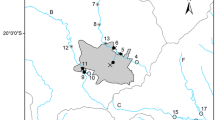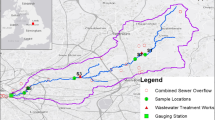Abstract
Accelerated pollution and eutrophication of rivers and streams because of human activity are a concern throughout the world and severe in Africa where Ethiopia is case in point. The objective of this study was to assess the urban impact on the ecological integrity of the Borkena River at the eastern escarpment of the central Ethiopian highlands. The water quality status and macroinvertebrate distribution and diversity of the river were assessed during the dry and wet seasons. Diversity indices revealed that a severe decline in the ecological integrity of the Borkena River downstream of Dessie and within Kombolcha towns in terms of macroinvertebrate abundance and composition. Clustering and ordination analysis clearly separated reference sites from urban impacted sites. At the urban-impacted sites, dissolved oxygen was also depleted to 0.5 mg/l and BOD5 values were reached to a level of above 1,000 mg/l, with extremely low biological diversity of pollution-sensitive taxa. These patterns are the result of a combination of rampant dumping of untreated wastes exacerbated by geologic, topographic, climatic and land use factors.
Similar content being viewed by others
References
Alemayehu, T. (2001). The impact of uncontrolled waste disposal on surface water quality in Addis Ababa. SINET: Ethiopian Journal of Science, 24(1), 93–104.
APHA (1998). Standard methods for examination of water and wastewater (20th edn). Washington, DC: American Public Health Association, American Water Works Association and the Water and Environment Federation.
Ayenew, T., & Barbieri, G. (2005). Inventory of landslides and sustainability mapping in the Dessie area, North Ethiopia. Engineering Geology, 77(1–2), 1–15.
Bartram, J., & Balance, R. (Eds.) (2001). Water quality monitoring—a practical guide to the design and implementation of freshwater quality studies and monitoring programmes: Published on behalf of UNEPand WHO, (pp. 50–87). London: Spon Press.
Burcher, C. L., & Benfield, E. F. (2006). Physical and biological responses of streams to suburbanization of historically agricultural water shades. Journal of North American Benthological Society, 25(2), 356–369.
Cairns, J. (1995). Chemical versus biological pollution monitoring. In B. C. Rana (Ed.), Pollution and biomonitoring (pp. 7–25). New Delhi: Tata McGraw Hill.
Davies, A. (2001). The use and limits of various methods of sampling and interpretation of benthic macroinvertebrates. Journal of Limnolology, 60(supp l.1), 1–6.
Devi, R., Tesfahune, E., Legesse, W., Deboch, B., & Beyene, A. (2008). Assessment of siltation and nutrient enrichment of Gilgel Gibe dam, southwest Ethiopia. Bioresource Technology, 9(5), 975–979.
Downes, B. J., Lake, P. S., & Schreiber, E. S. G. (1995). Habitat structure and invertebrate assemblages on stream stones: A multivariate view from the riffle. Australian Journal of Ecology, 20(4), 502–514.
Dudgeon, D. (1994). The influence of riparian vegetation on macroinvertebrate community structure and functional organization in six new Guinea streams. Hydrobiologia, 294(1), 65–85.
Federal Democratic Republic of Ethiopia Central Statistical Authority (2004). Ethiopia statistical abstract 2003. Addis Ababa, 110, 1–147.
Federal Democratic Republic of Ethiopia Ministry of Water Resources (2002). Ethiopian guidelines specification for drinking water quality. Addis Ababa, 1, 1–112.
Flintan, F., & Imeru, T. (2002). Spilling blood over water? The case of Ethiopia. In J. Lind, & K. Sturman (Eds.), Scarcity and surfeit: The ecology of Africa’s conflicts. African Centre for Technology Studies (Kenya) and Institute for Security Studies (South Africa).
Fore, L. S., Karr, J. R., & Wisseman, R. W. (1996). Assessing invertebrate responses to human activities: Evaluating alternative approaches. Journal of the North American Benthological Society, 15(2), 212–231.
Gerth, W. J., & Herlihy, A. T. (2006). Effect of sampling different habitat types in regional macroinvertebrate bioassessment surveys. Journal of the North American Benthological Society, 25(2), 501–512.
Hailu, D., & Legesse, W. (1997). Assessment of pollution status of Awetu stream, Ethiopia. Bulletin of Jimma Institute of Health Sciences, 7(2), 79–85.
Harrison, A. D., & Hynes, H. B. N. (1988). Benthic fauna of Ethiopia streams and rivers. Archiv für Hydrobiologie, supplement series, 81, 1–36.
Hauer, F. R., & Lamberti, G. A. (Eds.) (2006). Methods in stream ecology (2nd edn, pp. 51–79). New York: Academic.
Hilsenhoff, W. L. (1988). Rapid field assessment of organic pollution with a family-level biotic index. Journal of the North American Benthological Society, 7(1), 65–68.
Jackson, L. E., Janis, C. K., & Williams, S. F. (Eds.) (2000). Evaluation guidelines for ecological indicators. EPA/670/ R-99/005. U.S. Environmental Protection Agency, Office of Research and Development, Research Park, NC, pp. 107.
Jacobsen, D., Schultz, R. Z., & Encalada, A. (1997). Structure and diversity of stream invertebrate assemblages: The influence of temperature with altitude and latitude. Freshwater Biology, 38(2), 247–261.
Jongman, R. H. G., ter Braak, C. J. F., & van Tongeren, O. F. R. (Eds.) (1995). Ordination Data analysis in community and landscape ecology (pp. 91–173). Cambridge, UK: Cambridge University Press.
Jonnalagadda, S. B., & Mhere, G. (2001). Water quality of the Odzi River in the Eastern Highlands of Zimbabwe. Water Research, 35(10), 2371–2376.
Kumie, A., & Kloos, H. (2006). Occupational health and industrial pollution. In Y. Berhane, D. Haile Mariam, & H. Kloos (Eds.), The epidemiology and ecology of health and disease in Ethiopia (pp. 171–195). Addis Ababa: Shama Books.
Maddock, I. (1999). The importance of physical habitat assessment for evaluating river health. Freshwater Biology, 41(2), 373–391.
Mathooko, J. M., & Mavuti, K. M. (1992). Composition and seasonality of benthic macroinvertebrates and drift in Naro Moru River Kenya. Hydrobiologia, 232, 47–56.
Nathanson, J. A. (2000). Basic environmental technology: Water supply, waste management, and pollution control (3rd edn). USA: Prentice-Hall.
Ndiritu, G. G., Gichuki, N. N., Kaur, P., & Triest, L. (2003). Characterization of environmental gradients using physico-chemical measurements and diatom densities in Nairobi River, Kenya. Aquatic Ecosystem Health & Management, 6(3), 343–354.
Nelson, S. M., & Roline, R. A. (1996). Recovery of a stream macroinvertebrates community from mine drainage disturbances. Hydrobiologia, 339, 73–84.
Ostermiller, J. D., & Hawkins, C. P. (2003). Effects of sampling error on bioassessments of stream ecosystems: Application to RIVPACS-type models. Journal of the North American Benthological Society, 23(2), 363–382.
Reynoldson, T. B., Norris, R. H., Resh, V. H., Day, K. E., & Rosenberg, D. M. (1997). The reference condition: A comparison of multimetric and multivariate approaches to assess water-quality impairment using benthic macroinvertebrates. Journal of the North American Benthological Society, 16(4), 833–852.
Strong, W. L. (2002). Assessing species abundance unevenness within and between plant communities. Community Ecology, 3(2), 237–246.
Suren, A. M. (1994). Macroinvertebrate communities of streams in western Nepal: Effects of altitude and land use. Freshwater Biology, 32(2), 323–336.
ter Braak, C. J. F., & Smilauer, P. (2002). CANOCO reference manual and CanocoDraw for windows user’s guide: Software for canonical community ordination (version 4.5)(p. 500). Ithaca, NY, USA: Microcomputer Power.
Tumwesigye, C., Yusuf, S. K., & Makanga, B. (2000). Structure and composition of benthic macroinvertebrates of tropical forest stream, river Nyamweru, Western Uganda. African Journal of Ecology, 38, 72–77.
Voutsa, D., Manoli, E., Samara, C., Sofoniou, M., & Stratis, I. (2001). A study of surface water quality in Macedonia, Greece: Speciation of Nitrogen and Prosperous. Journal of Water, Air, Soil Pollution, 129(1–4), 13–32.
World Meteorological Organisation (1996). Global Environment Outlook 2000 (GEO). London: UNEP, Earthscan.
Author information
Authors and Affiliations
Corresponding author
Rights and permissions
About this article
Cite this article
Beyene, A., Legesse, W., Triest, L. et al. Urban impact on ecological integrity of nearby rivers in developing countries: the Borkena River in highland Ethiopia. Environ Monit Assess 153, 461–476 (2009). https://doi.org/10.1007/s10661-008-0371-x
Received:
Accepted:
Published:
Issue Date:
DOI: https://doi.org/10.1007/s10661-008-0371-x




